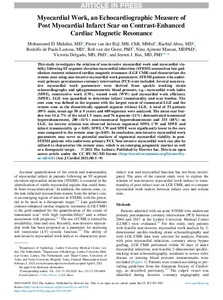Myocardial Work, an Echocardiographic Measure of Post Myocardial Infarct Scar on Contrast-Enhanced Cardiac Magnetic Resonance
van der Bijl Pieter; de Paula Lustosa Rodolfo; Ajmone Marsan Nina; Mahdiui Mohammed El; Delgado Victoria; van der Geest Rob; Bax Jeroen J; Abou Rachid
Myocardial Work, an Echocardiographic Measure of Post Myocardial Infarct Scar on Contrast-Enhanced Cardiac Magnetic Resonance
van der Bijl Pieter
de Paula Lustosa Rodolfo
Ajmone Marsan Nina
Mahdiui Mohammed El
Delgado Victoria
van der Geest Rob
Bax Jeroen J
Abou Rachid
Elsevier
Julkaisun pysyvä osoite on:
https://urn.fi/URN:NBN:fi-fe2021093048786
https://urn.fi/URN:NBN:fi-fe2021093048786
Tiivistelmä
This study investigates the relation of non-invasive myocardial work and myocardial viability following ST-segment elevation myocardial infarction (STEMI) assessed on late gadolinium contrast enhanced cardiac magnetic resonance (LGE CMR) and characterizes the remote zone using non-invasive myocardial work parameters. STEMI patients who underwent primary percutaneous coronary intervention (PCI) were included. Several non-invasive myocardial work parameters were derived from speckle tracking strain echocardiography and sphygmomanometric blood pressure, e.g.: myocardial work index (MWI), constructive work (CW), wasted work (WW) and myocardial work efficiency (MWE). LGE was quantified to determine infarct transmurality and scar burden. The core zone was defined as the segment with the largest extent of transmural LGE and the remote zone as the diametrically opposed segment without LGE. A total of 53 patients (89% male, mean age 58 ± 9 years) and 689 segments were analyzed. The mean scar burden was 14 ± 7% of the total LV mass, and 76 segments (11%) demonstrated transmural hyperenhancement, 280 (41%) non-transmural hyperenhancement and 333 (48%) no LGE. An inverse relation was observed between segmental MWI, CW and MWE and infarct transmurality (p < 0.05). MWI, CW and MWE were significantly lower in the core zone compared to the remote zone (p<0.05). In conclusion, non-invasive myocardial work parameters may serve as potential markers of segmental myocardial viability in post-STEMI patients who underwent primary PCI. Non-invasive myocardial work can also be utilized to characterize the remote zone, which is an emerging prognostic marker as well as a therapeutic target.
Kokoelmat
- Rinnakkaistallenteet [19207]
